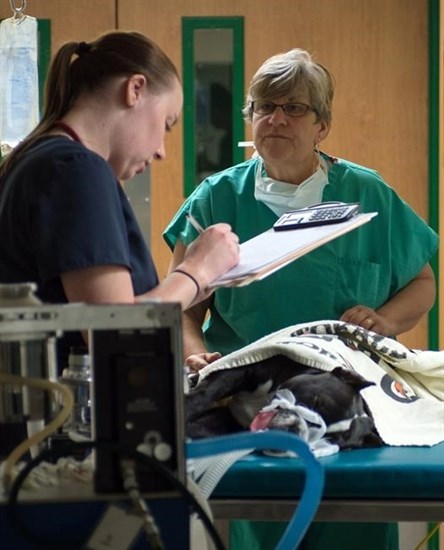
In this Thursday, May 14, 2015 photo provided by Michigan State University, senior DVM student, left, and licensed veterinary technician Monica Conklin monitor Mr. Moo under general anesthesia before he is moved into the operating room for his cleft palate surgery at Michigan State University's College of Veterinary Medicine in Lansing, Mich.
Image Credit: G.L. Kohuth/Michigan State University via AP
October 11, 2015 - 9:00 PM
LOS ANGELES, Calif. - Dogs, like people, can be born with cleft palates. Some die from pneumonia or malnourishment. Some with the defect, which is basically a hole in the mouth, are euthanized.
But the same techniques that repair cleft palates in children can be used with dogs — even in challenging cases like Mr. Moo, a 9-month-old mixed breed puppy who was eating through a tube because of a cleft palate.
Usually soft tissue from the same area of the mouth is used to build a flap to cover the hole. But there was no soft tissue near Mr. Moo's defect. Dr. Bryden Stanley, chief of surgery for small animals at Michigan State University's College of Veterinary Medicine in Lansing, wasn't sure how to solve the problem.
Then she met Dr. John Girotto, director of craniofacial surgery at Helen DeVos Children's Hospital in Grand Rapids, Michigan. Girotto told Stanley he would do for the puppy what he does for children with no soft tissue — take it from the inside of the cheek.
In May, Mr. Moo underwent the surgery. It was believed to be the first time that technique was ever performed on a dog. Mr. Moo is doing fine and has healed nicely, Stanley said. The dog's owners did not want to be interviewed.
"One in 700 children will be born with either a cleft lip or a cleft palate, which makes it a fairly common birth defect," Girotto said.
There are no statistics on how common the defect is in dogs. But one study suggested cleft palate was more prevalent in purebreds and flat-nosed dogs. Dr. Danika Bannasch at the University of California, Davis, has published two papers on the topic with a focus on Labrador retrievers, whippets and boxers.
Cleft lip occurs when the lips do not grow together in the front. Stanley especially likes to repair cleft lips in dogs. "I love correcting those, they are so obvious. They are the cutest little puppies ever and well worth repairing," Stanley said.
Stanley and Girotto are working with two MSU geneticists who are investigating what causes the defects with help from eight of Stanley's four-legged patients. Results from genetic research on dogs is often available much more quickly than research on humans because dogs age faster.
There are some differences in treating dogs and humans. Dogs normally get two surgeries and they're done, Stanley said. Dogs don't need braces for smiling or a speech therapist for talking.
But children with cleft palates are seen by a craniofacial surgeon, plastic surgeon, dentist, orthodontist, speech therapist, and ear, nose and throat doctor, plus, often, a social worker and geneticist, Girotti said.
"It takes a multidisciplinary team. We put a whole group of support around that family and that child because in different stages of life, different things become important," he said.
Stanley and Girotto plan to have the dogs they treat for cleft palates trained to help kids having the same surgery.
Breeders who don't want to keep dogs with the defect should "send them to Lansing," where doctors will repair their faces and turn them into therapy dogs, Girotti said.
___
Online:
— cvm.msu.edu
— www.helendevoschildrens.org
News from © The Associated Press, 2015